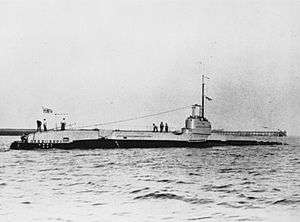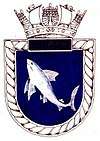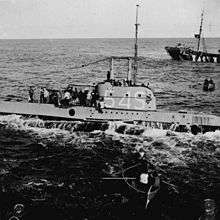HMS Shark (54S)
 HMS Shark | |
| History | |
|---|---|
| Class and type: | S-class submarine |
| Name: | HMS Shark |
| Builder: | Chatham Dockyard |
| Laid down: | 12 May 1933 |
| Launched: | 31 May 1934 |
| Commissioned: | 31 December 1934 |
| Fate: | Sunk on 6 July 1940 |
| General characteristics | |
| Displacement: |
|
| Length: | 208 ft 9 in (63.63 m) |
| Beam: | 24 ft (7.3 m) |
| Draught: | 10 ft 6 in (3.20 m) |
| Propulsion: | Twin diesel/electric |
| Speed: |
|
| Complement: | 39 officers and men |
| Armament: |
|

HMS Shark was a Royal Navy S-class submarine which was launched on 31 May 1934 and fought in the Second World War. Shark is one of twelve boats named in the song "Twelve Little S-Boats".
Service history

The submarine was attacked by German aircraft while surfacing on patrol off the coast of Norway near Skudenes 5 July 1940. While trying to fight off the aircraft, the submarine succeeded in shooting down a Dornier Do 17.[1] Due to the damage the submarine had suffered and likely further attack from the enemy aircraft overhead it was decided to surrender the submarine. The next day at about 0400 the German minesweeping trawlers M-1803, M-1806 and M-1807 arrived at the scene and took the crew on board. [2] Shark was taken under tow but the crew had scuttled her prior to leaving. Amidst much cheering from the captured British sailors, the German trawler crews were forced to cut the hawsers before Shark sank and took the towing vessels with her. Shark sank stern first about 25 nautical miles (46 km) west-south-west of Egersund, Norway.
The boat's captain, Lieutenant Commander Peter Buckley, was involved in planning a number of escape attempts from POW camp.[3] ERA W. E. "Wally" Hammond made a number of escape attempts before being held in Oflag IV-C – Colditz. With ERA Don "Tubby" Lister (from the captured submarine HMS Seal) he made a successful escape by campaigning for a transfer from Colditz, arguing that he was not an officer. He was transferred to Lamsdorf prison, escaped from a Breslau work party, and reached England via Switzerland in 1943.[4][5]
See also
References
- ↑ Kemp, Paul (1999). The Admiralty Regrets: British Warship Losses of the 20th Century. Sutton Publishing Ltd. p. 123. ISBN 0-7509-1567-6.
- ↑ "Submarine losses 1904 to present day". Royal Navy Submarine Museum. Archived from the original on 15 December 2004.
- ↑ Preston, Antony (2001). The Royal Navy Submarine Service: A Centennial History. Conway Maritime Press. p. 115. ISBN 0-85177-891-7.
- ↑ Reid, Patrick Robert (1953). The Latter Days at Colditz. London: Hodder and Stoughton
- ↑ "Prisoners of war in Switzerland". Sea Your History. Royal Naval Museum. Archived from the original on 21 July 2011. Retrieved 16 June 2018.
External links
Sources
- Colledge, J. J.; Warlow, Ben (2006) [1969]. Ships of the Royal Navy: The Complete Record of all Fighting Ships of the Royal Navy (Rev. ed.). London: Chatham Publishing. ISBN 978-1-86176-281-8. OCLC 67375475.